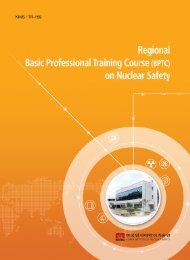PROSPER guidelines - Nuclear Safety and Security - IAEA
PROSPER guidelines - Nuclear Safety and Security - IAEA
PROSPER guidelines - Nuclear Safety and Security - IAEA
Create successful ePaper yourself
Turn your PDF publications into a flip-book with our unique Google optimized e-Paper software.
4.3. ORGANIZATION<br />
1. Are management expectations of personnel specified with regard to reporting<br />
abnormalities? Are the roles <strong>and</strong> responsibilities of personnel involved in processing<br />
operational safety performance data adequately specified? Are the roles <strong>and</strong><br />
responsibilities of personnel responsible for event investigation, analysis, corrective action<br />
development <strong>and</strong> implementation adequately specified?<br />
2. Are the OE processes adequately specified <strong>and</strong> are expectations clearly understood by<br />
plant personnel?<br />
3. Are specialist staff, other than dedicated OE review personnel, involved in the analysis of<br />
operating experience information <strong>and</strong> the development of corrective actions?<br />
4. Are adequate resources devoted to the OE processes (equipment, personnel, finance)?<br />
5. Are there effective channel of communication with external sources of OE information?<br />
4.4. ACTIVITIES<br />
4.4.1. Event/deviation reporting <strong>and</strong> tracking<br />
1. Is event <strong>and</strong> deviation reporting comprehensive. Is minor, low level <strong>and</strong> near miss<br />
reporting actively encouraged? Is there a declared policy of no-blame reporting — what is<br />
the staff perception — is it considered punitive?<br />
2. Is reporting of deviations, events, precursors, etc. carried out by all the different levels of<br />
personnel, sections, departments, etc. throughout the plant organization? Do all staff<br />
contribute?<br />
3. Is the reporting process user friendly? Are the relevant plant personnel fully aware of the<br />
process?<br />
4. How accessible is the event report information to plant personnel?<br />
5. Are the reporting requirements communicated to plant personnel during initial <strong>and</strong><br />
refresher training? What other methods are used to convey management’s expectations on<br />
reporting?<br />
6. Are reports tracked to ensure analysis is complete <strong>and</strong> corrective action taken etc.?<br />
7. Is there a tendency in reporting either equipment, procedural or personnel deficiencies?<br />
8. Is there physical evidence in the plant of unreported deficiencies, event precursors or error<br />
likely situations (e.g. defective equipment, poor material condition, poor or unsafe<br />
working practices, un-controlled operator aids, lack of document control, etc.)?<br />
9. How comprehensive is event reporting <strong>and</strong> is information centralized?<br />
10. Are deviations identified by relevant review programmes (e.g. QA, surveillance testing,<br />
management tours. etc.)?<br />
4.4.2. Screening of reports for significance<br />
1. Are criteria for in-depth investigation <strong>and</strong> root cause analyse established? Are there clear<br />
responsibilities for this decision making?<br />
2. Is timely screening for reporting purposes or assessment of effect on plant evident? Is<br />
there evidence of dissatisfaction from receivers (e.g. regulatory bodies <strong>and</strong> other off-site<br />
authorities, utility, international organizations, etc.) regarding timeliness of reporting? Is<br />
there a backlog of events to be analysed — if so, how significant are they?<br />
3. Is there a threshold for exclusion of events? If so, is that threshold appropriate?<br />
4. Are the plant reporting criteria adequately defined <strong>and</strong> are they comprehensive?<br />
32
















